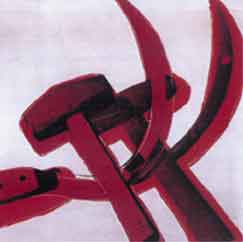Commodification the work
Brutal accidents, the death penalty, consumption,
ideological icons such as the US dollar symbol or the hammer and the sickle,
media icons such as Marylin Monroe and Elvis Presley, etc., are recurrent
themes in the paintings of Andy Warhol, who took his stance as an artist
from the ambivalence between mass culture and high culture, by means of
the ambiguity with which he manipulated and exploited images and symbols
related to the consumer society. For that reason, in spite of the conceptual
and critical implications of his repertory, –such as, for instance,
his Oxidation Painting– the treatment of the images makes
us rather uneasy about their ideological interpretation. This is achieved
through different techniques. One is the decontextualisation of these
real images, which are no longer photographs published in newspapers and
are granted the condition of works of art by their being placed in the
museum. In that aspect Warhol cancels/revokes the spectators’ loss
of sensitivity in the face of the mass reproduction of images with dramatic
content in the media, precisely restoring their condition of fetishes,
inherent to their being works of art.
Another technique is the repetition of icons, which takes place within
the space –by repeating the same theme in a series of works–
or sequentially in the same piece. That repetition technique creates a
fetish, by emptying images of ideology. In the case of Hammer and Sickle
(1976), an icon with clear political and ideological references such as
the hammer and sickle becomes a spectacular image, which dilutes its symbolic
effect, but, by making an intelligent use of the conventions that govern
vision in the contemporary world, is also situated in the dialectical
territory of memory and history.

Andy Warhol, Hammer and Sickle, 1976
